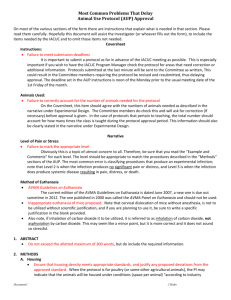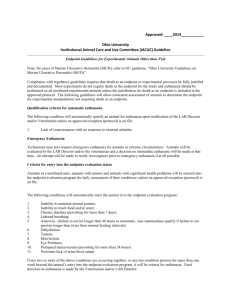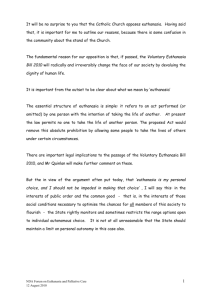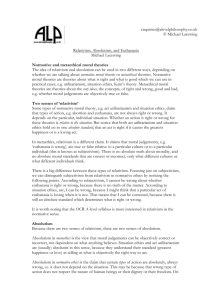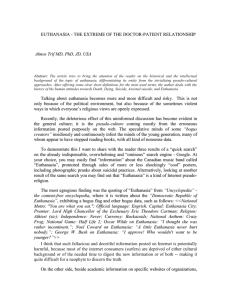Clinical signs of pain or distress that require euthanasia
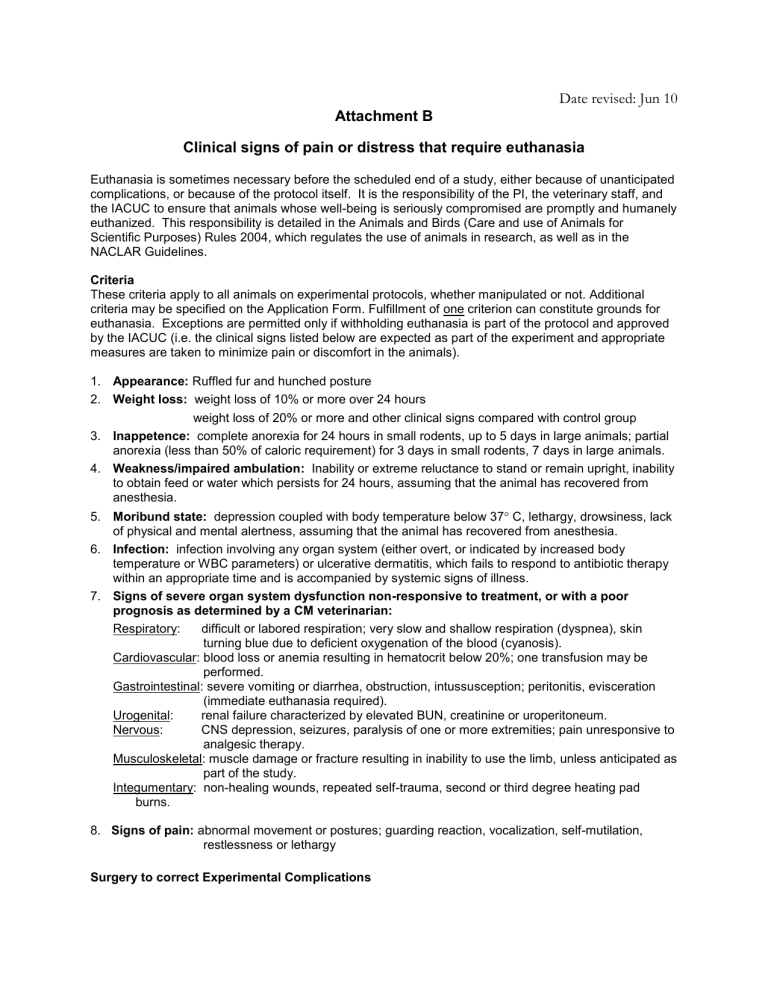
Date revised: Jun 10
Attachment B
Clinical signs of pain or distress that require euthanasia
Euthanasia is sometimes necessary before the scheduled end of a study, either because of unanticipated complications, or because of the protocol itself. It is the responsibility of the PI, the veterinary staff, and the IACUC to ensure that animals whose well-being is seriously compromised are promptly and humanely euthanized. This responsibility is detailed in the Animals and Birds (Care and use of Animals for
Scientific Purposes) Rules 2004, which regulates the use of animals in research, as well as in the
NACLAR Guidelines.
Criteria
These criteria apply to all animals on experimental protocols, whether manipulated or not. Additional criteria may be specified on the Application Form. Fulfillment of one criterion can constitute grounds for euthanasia. Exceptions are permitted only if withholding euthanasia is part of the protocol and approved by the IACUC (i.e. the clinical signs listed below are expected as part of the experiment and appropriate measures are taken to minimize pain or discomfort in the animals).
1.
Appearance: Ruffled fur and hunched posture
2.
Weight loss: weight loss of 10% or more over 24 hours
weight loss of 20% or more and other clinical signs compared with control group
3. Inappetence: complete anorexia for 24 hours in small rodents, up to 5 days in large animals; partial anorexia (less than 50% of caloric requirement) for 3 days in small rodents, 7 days in large animals.
4. Weakness/impaired ambulation: Inability or extreme reluctance to stand or remain upright, inability to obtain feed or water which persists for 24 hours, assuming that the animal has recovered from anesthesia.
5. Moribund state: depression coupled with body temperature below 37
C, lethargy, drowsiness, lack of physical and mental alertness, assuming that the animal has recovered from anesthesia.
6. Infection: infection involving any organ system (either overt, or indicated by increased body temperature or WBC parameters) or ulcerative dermatitis, which fails to respond to antibiotic therapy within an appropriate time and is accompanied by systemic signs of illness.
7. Signs of severe organ system dysfunction non-responsive to treatment, or with a poor prognosis as determined by a CM veterinarian:
Respiratory: difficult or labored respiration; very slow and shallow respiration (dyspnea), skin turning blue due to deficient oxygenation of the blood (cyanosis).
Cardiovascular: blood loss or anemia resulting in hematocrit below 20%; one transfusion may be performed.
Gastrointestinal: severe vomiting or diarrhea, obstruction, intussusception; peritonitis, evisceration
(immediate euthanasia required).
Urogenital: renal failure characterized by elevated BUN, creatinine or uroperitoneum.
Nervous: CNS depression, seizures, paralysis of one or more extremities; pain unresponsive to analgesic therapy.
Musculoskeletal: muscle damage or fracture resulting in inability to use the limb, unless anticipated as part of the study.
Integumentary: non-healing wounds, repeated self-trauma, second or third degree heating pad burns.
8. Signs of pain: abnormal movement or postures; guarding reaction, vocalization, self-mutilation, restlessness or lethargy
Surgery to correct Experimental Complications
Only one major surgical procedure (involving entry of abdomen or thorax) may be performed per animal, unless indicated on an approved protocol. Therefore, major surgery intended to correct complications arising after a major experimental procedure is not permitted without prior approval. In such cases, euthanasia must be performed. Procedures such as repair of dehiscences and wound cleaning/debridement for treatment of infection may be performed following notification of the LAC veterinary staff or the attending veterinarian for the facility.
Clinical signs of pain and/or distress that require euthanasia in cancer studies.
Criteria Examples Clinical signs/Assessments
Tumour Size
Physical
Characteristics of Tumour(s)
Tumour
Location
Weight loss
Estimated tumor mass not to exceed 10% of body weight.
Evidence of necrosis
Evidence of sepsis
Evidence of metastasis
Head/neck and extremities
Cachexia, muscle wasting
Frequent weighing and measurements of solitary tumour (3-5 times/week).
The estimated weight of tumour (1cm 3 = approx. 1 g) should not be more than 10% of the animal body weight.
10% would represent subcutaneous flank tumour diameter of about 1.5cm in mouse or 2.5cm in rat.
Physical examination:
Scabbing, ulceration of tumours, bloodstained or mucopurulent discharge from any orifice, anorexia, hypothermia, etc.
Frequent monitoring:
Inability to access or ingest food and water, inability to ambulate and keep clean
Frequent weighing:
Weight loss of 10% or more over 24 hr, 20% or more
and other clinical signs compared with control group.
Signs of severe organ system dysfunction
Moribund or
Pre-moribund
State
Respiratory
Cardiovascular
Gastrointestinal
Nervous
Integumentary
Define with specific clinical tests or signs
Frequent monitoring:
Dyspnea, rapid or labored breathing, coughing, rales
Shock, hemorrhage, anaphylaxis
Diarrhea (>2 days' duration), vomiting
Circling, blindness, dementia, convulsions, unresponsiveness
Extensive hair loss, inflammation, self-trauma
Frequent monitoring:
Depression coupled with hypothermia,
Unconscious or comatose, lethargic or failure to respond to gentle stimuli



